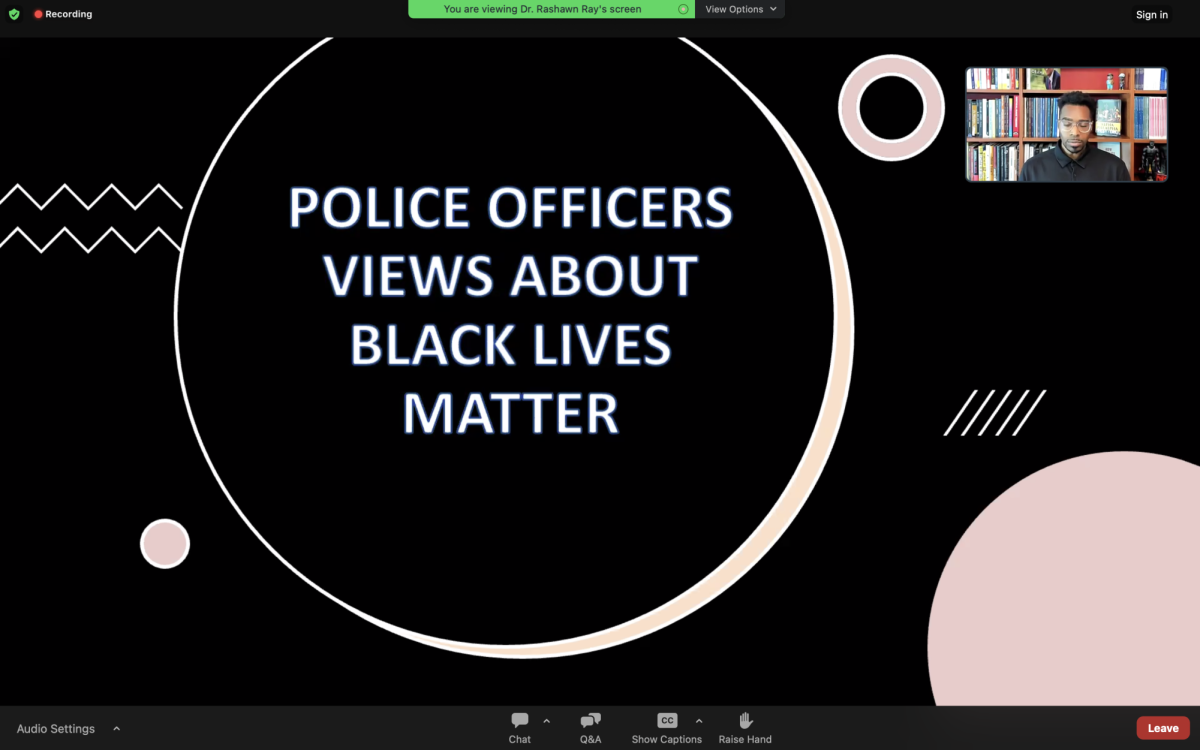A study researching implicit bias in American police forces found that people have the same reaction to snakes and spiders as they do to Black individuals in close proximity, Rashawn Ray, professor of sociology at the University of Maryland, College Park, said while explaining the reasoning for harsh policing against the Black community.
“Implicit bias is deeply embedded in organizational culture and leads to structurally imposed racial disparities,” Ray said.
Ray spoke at a Zoom webinar on Wednesday titled “Rotten Trees: Racism and Bad Apples in American Policing.” The event is part of a lecture series headlined by the Africana studies departments at the University of Pittsburgh, Brown University and the W.E.B Dubois Department of Afro-American Studies at the University of Massachusetts, Amherst, titled, “Africana Studies: Renewing the Fight for Justice.” Ray discussed studies and statistics that demonstrate how policing disproportionately affects Black people.
Speaking on structural and implicit bias, Ray joined together with the University of Maryland, College Park’s Lab for Applied Social Science and Google to create an immersive virtual reality experience that explored racial preferences and bias. The lab, in curating specific experiences, routinely changed the race of the characters involved. Ray said the reactions of the officers within the experiment changed quite blatantly depending on the race of the “person” they interacted with.
The lecture began with Ray displaying a photograph of George Floyd’s memorial. He went on to display several statistics, one noting that over 50% of white people claimed that policing issues — specifically against Black individuals — contributed to a broader issue in society. This sentiment, Ray explained, is a byproduct of the reaction to the murders of young Black teens and men such as Trayvon Martin, Michael Brown and George Floyd.
However, Ray also said in 2021 the government responded by attempting to pass the George Floyd Justice in Policing Act, which Ray himself advocated for.
“Current things happening in Washington helped drive that legislation away,” Ray said.
Ray drove the focus back to specific data on policing, both prior to and after the death of George Floyd in 2020. He focused primarily on the death of Michael Brown, whose killing in Ferguson, Missouri, launched a plethora of social media outcries. Ray said the death of the 18-year-old generated nearly 32 million tweets after the fact.
The conversation turned to the very public case of Trayvon Martin — a Black teenager killed in 2012 by police officer George Zimmerman. Martin, who was walking home from the store, was followed home by Zimmerman who, after somewhat of a struggle, shot and killed Martin. In a public trial, Zimmerman was acquitted of charges against him for killing Martin. After Martin’s death, the Homeowner’s Association paid more than $1 million to the Martin family in Sanford, Florida.
“Is this the cost of a teenager’s life?” Ray said. “If you are Tracy Martin, Trayvon’s father, how would you feel if your own money is being used to pay for your son’s life?”
Ray said specifically after the death of Trayvon Martin, the Black Lives Matter movement began to firmly take shape on social media. Increased displays of activism, both on and off social media, began to grow rapidly at this time as the movement surged onward, according to Ray.
“Social media plays a role in humanizing the marginalized,” Ray said.
Ray spoke about how Black boys, specifically in the case of Michael Brown, are often “aged up” to appear more dangerous. Doing this allows their killers to justify their murders, alongside the fact that law enforcement officers are often given a specific script when told to recap their experiences in the homicides of Black individuals, according to Ray. Michael Brown, specifically, in an image formed under the conservative social media group “TCOT” (Top Conservatives on Twitter) was depicted as a “huge monster” seen towering over and crushing a policeman and his vehicle in the image.
During the webinar, Ray continued to delve into more extensive statistics regarding prejudices and policing, specifically toward and about Black men. He spoke heavily on the former “stop and frisk” policy, and said approximately 70,000 of all people stopped by police in 2011 were Black, 56% of these stops involved frisks and only about 2% of stops led to the discovery of contraband. 86% of these stops led to nothing at all, according to Ray.
“These statistics are about Blackness, not about compliance,” Ray said.
Ray said Black people are 3.5 times more likely to be killed by police when they are not holding a weapon or displaying acts of aggression. Studies also show police killings and violent crime rates are often unrelated, and the matter of the social class of Black individuals plays no part in their killings. Affluent Black people are killed almost as commonly as low-income Black people, according to Ray.
“Racial bias is there,” Ray said. “There is always a propensity for these biases to happen based on their training.”



